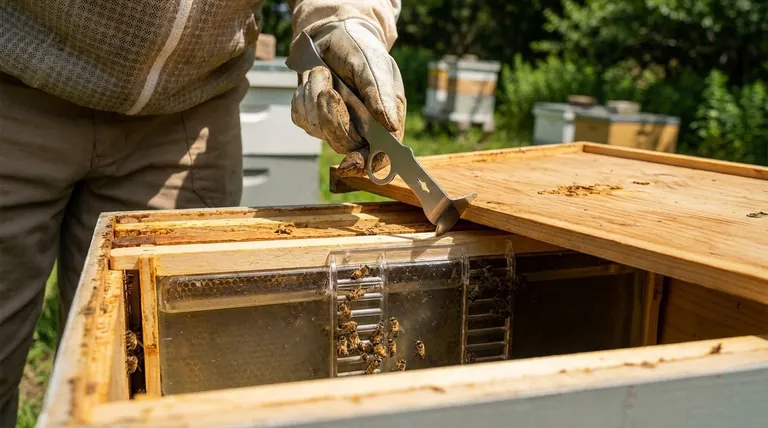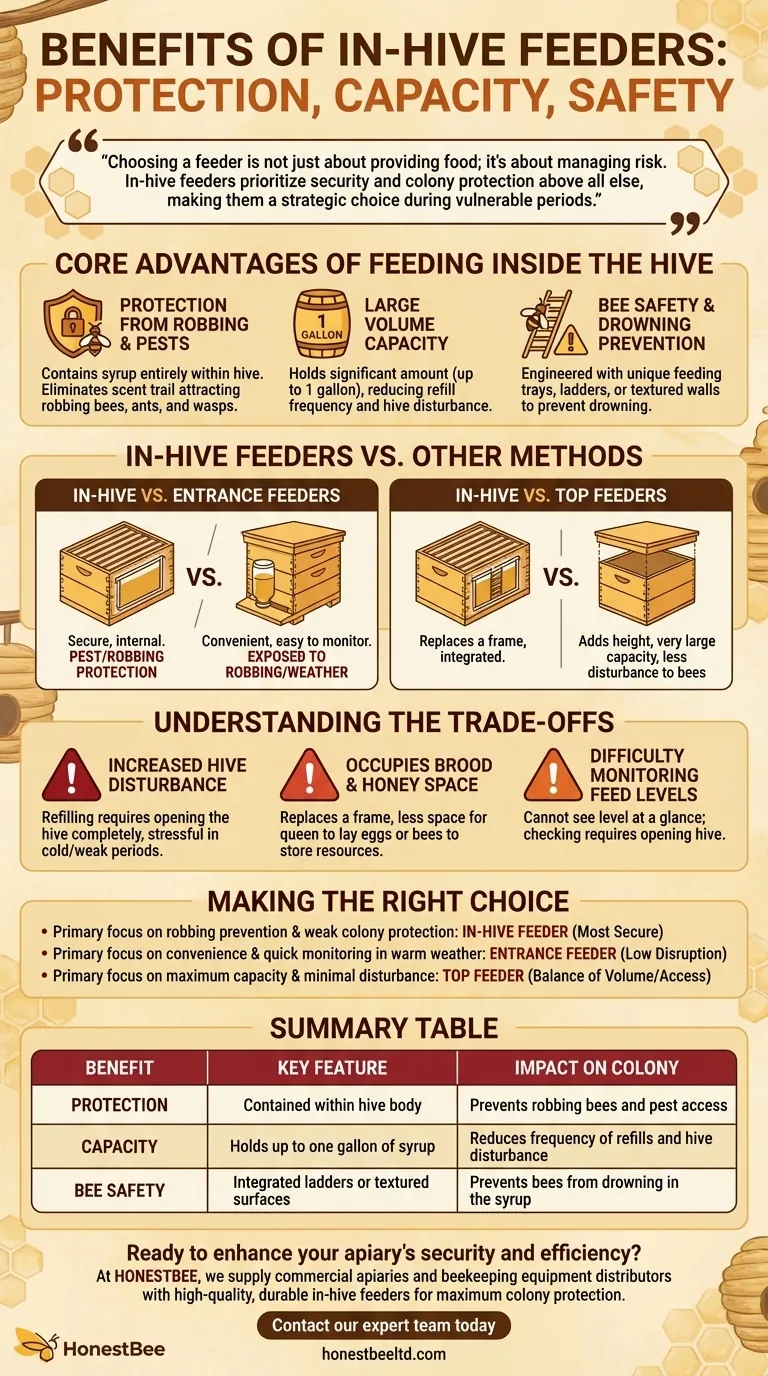The primary benefits of an in-hive feeder are protection, capacity, and bee safety. By placing the food source directly inside the hive body in place of a frame, it isolates the syrup from outside pests and robbing bees from other colonies. These feeders can hold a large volume of syrup and often include built-in features to prevent your bees from drowning.
Choosing a feeder is not just about providing food; it's about managing risk. In-hive feeders prioritize security and colony protection above all else, making them a strategic choice during vulnerable periods.

The Core Advantages of Feeding Inside the Hive
Placing a feeder inside the hive architecture offers distinct advantages over external methods. The design directly addresses common beekeeping challenges related to pests, weather, and colony health.
Protection from Robbing and Pests
By containing the syrup entirely within the hive, you eliminate the scent trail that can attract robbing bees from other colonies. This also protects the food source from ants, wasps, and other pests that are drawn to easy sugar sources.
Large Volume Capacity
In-hive frame feeders are designed to hold a significant amount of syrup, often up to one gallon. This large capacity reduces the frequency of refills, minimizing disturbance to the colony.
Bee Safety and Drowning Prevention
Modern in-hive feeders are engineered with bee safety in mind. They typically include a unique feeding tray, ladders, or textured inner walls that allow bees to access the syrup without falling in and drowning, a common problem with more primitive feeder designs.
In-Hive Feeders vs. Other Common Methods
To understand the value of an in-hive feeder, it's essential to compare it to the alternatives. Each method serves a different purpose and is suited to different conditions.
In-Hive vs. Entrance Feeders
Entrance feeders are convenient because the jar is outside the hive, making it exceptionally easy to monitor feed levels and refill without opening the hive.
However, their position at the entrance makes them a prime target for robbing bees. They are also exposed to the elements, making them less effective in cold weather when syrup can freeze.
In-Hive vs. Top Feeders
Top feeders sit on top of the uppermost hive box, also offering a very large capacity and the ability to be refilled without significantly disturbing the bees below.
The main difference lies in placement. While both are internal to the hive's outer shell, the in-hive feeder replaces a frame, integrating directly into the brood chamber, whereas a top feeder adds height to the hive.
Understanding the Trade-offs
No single piece of equipment is perfect for every situation. While in-hive feeders provide excellent protection, they come with notable trade-offs that are critical to consider.
Increased Hive Disturbance
The biggest drawback is that refilling requires you to open the hive completely. This disturbance can be stressful for the colony, especially during colder weather or periods of weakness.
Occupies Brood and Honey Space
An in-hive feeder takes the place of a frame. This means there is less physical space for the queen to lay eggs or for the bees to store nectar and pollen, which can be a limitation for a rapidly growing colony.
Difficulty Monitoring Feed Levels
Unlike an external entrance feeder, you cannot see the syrup level at a glance. Checking how much food is left requires you to open the hive, which negates the benefit of infrequent refilling if you need to check on it often.
Making the Right Choice for Your Colony
The best feeder depends entirely on your colony's specific needs, the time of year, and your beekeeping goals.
- If your primary focus is preventing robbing and protecting a weak colony: The in-hive feeder is the most secure option available.
- If your primary focus is convenience and quick monitoring in warm weather: An entrance feeder is an excellent, low-disruption choice.
- If your primary focus is maximum capacity with minimal disturbance: A top feeder provides a great balance of volume and ease of access.
Ultimately, selecting the right feeder is a key decision in supporting your colony’s health and security.
Summary Table:
| Benefit | Key Feature | Impact on Colony |
|---|---|---|
| Protection | Contained within the hive body | Prevents robbing bees and pest access |
| Capacity | Holds up to one gallon of syrup | Reduces frequency of refills and hive disturbance |
| Bee Safety | Integrated ladders or textured surfaces | Prevents bees from drowning in the syrup |
Ready to enhance your apiary's security and efficiency?
At HONESTBEE, we supply commercial apiaries and beekeeping equipment distributors with high-quality, durable in-hive feeders designed for maximum colony protection. Our wholesale-focused operations ensure you get the reliable equipment your operation needs.
Contact our expert team today to discuss your requirements and discover how our beekeeping supplies can support your colonies' health and productivity.
Visual Guide

Related Products
- HONESTBEE Advanced Ergonomic Stainless Steel Hive Tool for Beekeeping
- Professional Dual-End Stainless Steel Hive Tool for Beekeeping
- Professional 3-Bar Frame Grip with Integrated Hive Tool
- Beehive Handle and Frame Rest Cutting Machine: Your Specialized Hive Machine
- Yellow Plastic Bucket Pail Perch for Beekeeping
People Also Ask
- What are the basic tools for beekeeping? Essential Starter Kit for Safe & Successful Hive Management
- How should beekeepers handle bees when using a hive tool? Master Calm, Deliberate Techniques
- How is a hive tool used for scraping and cleaning? Master Hive Maintenance for a Healthy Colony
- What is the hole in a hive tool for? A Multi-Tool for Apiary Repairs and Maintenance
- What is a hive tool and what are its uses? Master Your Hive Inspections with the Essential Beekeeper's Tool



















